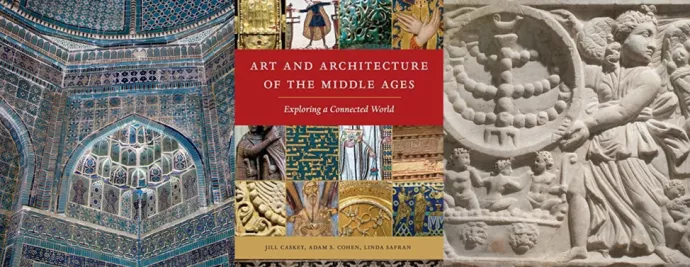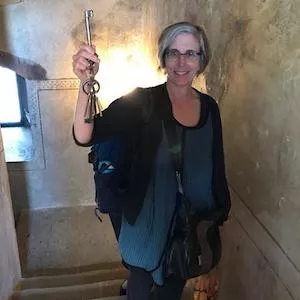
A More Modern-day Medievalism
There is no denying that in the field of art history, medieval art and architecture are well represented territory in research, including important textbooks like as Marilyn Stokstad’s Medieval Art and Henry Luttikhùizen and Dorothy Verberk’s Snyder’s Medieval Art. However, Professors Jill Caskey (Department of Visual Studies, UTM), Adam S. Cohen (Department of Art History, UofT), and Linda Safran (Pontifical Institute of Mediaeval Studies, UofT), concluded that these books, comprehensive as they may be, were not presenting the full picture and that an updated introduction to the field was needed.
Thus, Art and Architecture of the Middle Ages: Exploring a Connected World was born.

Co-authored by Caskey, chair of UTM’s Department of Visual Studies at UTM, Cohen, and Safran, it will be published in November 2022 by Cornell University Press.
“We felt that there should be a book that would introduce today’s students to the diversity of places and peoples in the medieval world and to a greater variety of works—not only cathedrals and icons,” says Caskey.
“We tried to maintain some familiar benchmarks to make the book useful for a range of courses. But we also really wanted to stretch beyond Eurocentric ideas that equate the Middle Ages with Christianity and see medieval art as an aberration or a prequel to what traditionally has mattered most: the Italian Renaissance.”
The resulting book is 400 pages with over 450 colour illustrations, and along with the inclusion of religious as well as secular arts, it also covers some Zoroastrian, Jewish, Christian, and Islamic traditions. The book is organized chronologically, spanning over 12 centuries of artistic production from ca. 300 CE to ca. 1400 CE, and with more diverse geographical migrations, including European, African, and Asian, than previous textbooks have presented.
Caskey, Cohen, and Safran have also assembled an open-access website that complements the book and includes resources, such as a glossary, maps, timelines, essays, and the podcast “Medieval Art Matters,” with several episodes that are a deep dive into medieval art and architecture with experts in related fields and associated topics. The first episode “Conceptualizing the Middle Ages” is an interview with UTM English & Drama faculty member and Vice-President and Principal Professor Alexandra Gillespie.
Working on this book also inspired aspects of Caskey’s current Connaught-funded Global Past project that she is undertaking with co-principal investigator, Ajay Rao, UTM’s vice-dean, graduate and postdoctoral affairs, and professor in the Department of Historical Studies.
Although Caskey says that she and her research team had to make cuts to several chapters in their book, mostly to the art and architecture from western Europe, they hope to present a more comprehensive and broader view of the art and architecture of this time period.
“We anticipate that Art and Architecture of the Middle Ages will prompt a range of responses. I imagine that some people will be upset that their favorite monuments or narratives aren’t included. And I’m sure others will think that we haven’t gone far enough in dismantling disciplinary norms. But I hope that many colleagues—and, most importantly, students—will love our more expansive approach,” says Caskey.
“Ultimately, we hope our work helps students appreciate and understand a more diverse Middle Ages, one that linked people and objects across Europe, western Asia, and North Africa, and that it stimulates our colleagues to continue exploring their own narratives about that connected world.”
Resources/acknowledgements
- Jill Caskey acknowledges the support from the Office of the Vice-Principal and Dean at the University of Toronto Mississauga that enabled her team to hire Erika Loic (now at Florida State) as a digital-humanities postdoc, who designed the architecture of the website and populated the first half of its Galleries section.
- Caskey and her team also acknowledges the financial support they received from the Social Sciences and Humanities Research Council of Canada (SSHRC) that helped them conduct on-site research and commission maps, architectural plans, and photographs for the book.
